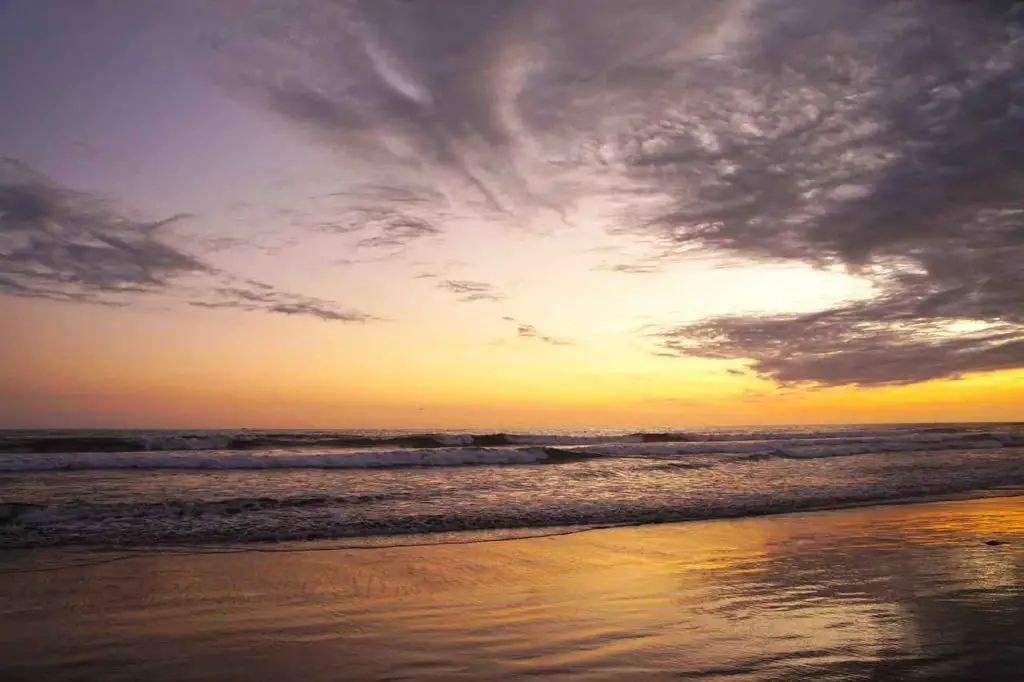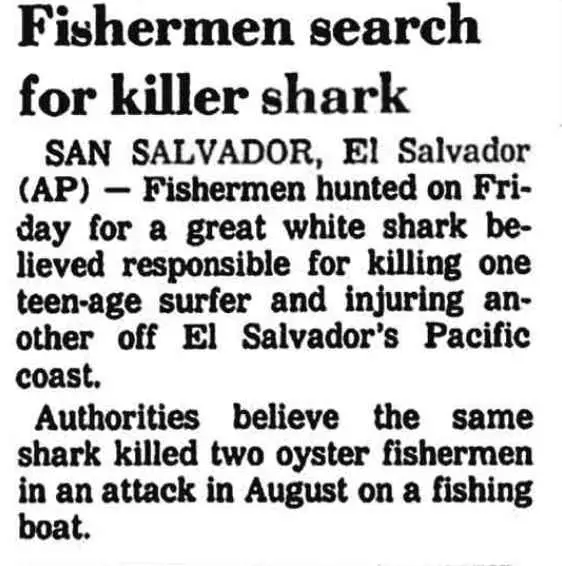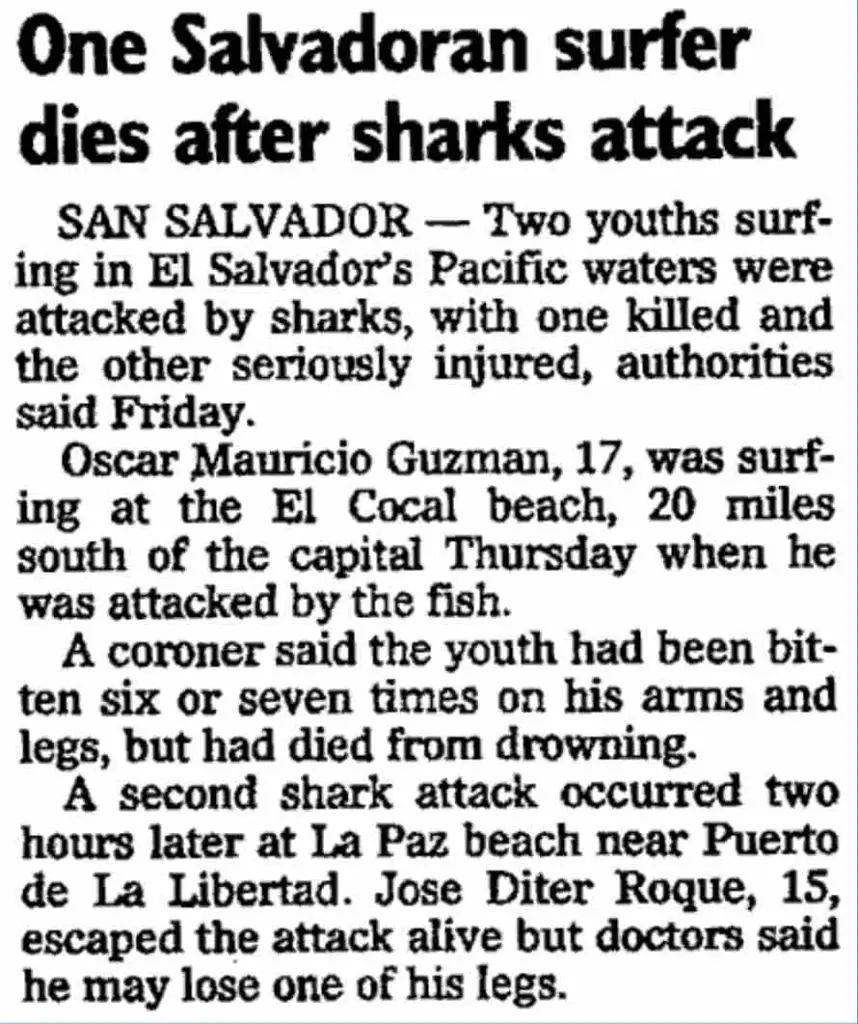El Salvador, meaning “The Saviour,” is a country in Central America. It is bordered by Honduras, Guatemala, and the Pacific Ocean. Despite being the only Central American country with no Caribbean coastline, El Salvador has a 307 km (191 mi) coastline on the Pacific.
With almost 200 miles of coast in the Pacific Ocean, and considering that the great waves make the country a paradise for surfers, some people may want to know if there are sharks in these waters before visiting. So, are there sharks in El Salvador?
At least nine shark species were confirmed in the waters near El Salvador, possibly including Great White Sharks. However, the number may be higher, as El Salvador is situated in the Pacific Ocean. Shark attacks are rare in the country: only four incidents since 1950, with three fatal victims.
Do you think being struck by lightning is a rare event? Well, dying in a shark attack is even more. Unfortunately, some incidents happen, as these sharp-teeth animals are gigantic and super strong. Even so, it is safe to say that shark attacks are very, very rare in El Salvador.
There are only four attacks (with three fatal victims) registered in the country since some institutes started keeping track of this type of incident. All of the deaths occurred in 1993, an unusual year in terms of shark fatalities in the region.
A Great White shark still is the number one suspect for all these killings in 1993 when two fishermen and a 17-year-old surfer lost their lives in 2 months. For more details about these stories, keep reading.
Read on to learn all about the shark attacks and the most common species in El Salvador.
Sharks In El Salvador: Most Common Species

El Salvador is a great touristic destination for those that love nature and beautiful beaches. With a warming people and easy-going lifestyle, the smallest country in Central America is gigantic in culture, great food, and wildlife, including sharks.
Nine shark species are common in El Salvador, but there are probably more as the country is bordered by the Pacific Ocean. The most common species are:
- Shortfin Mako
- Whale Shark
- Bigeye Thresher
- Common Thresher
- Scalloped Hammerhead
- Great Hammerhead
- Silky Shark
- Oceanic Whitetip Shark
- Great White Shark
Shark sightings are not usual in El Salvador, but these nine species were confirmed as dwellers of the beautiful Salvadorian coast. Considering that there are probably hundreds of shark species living in the Pacific Ocean, it’s entirely possible that other sharks are living or cruising around El Salvador.
The Great White Shark is not listed in the species guide from MOU (Memorandum of Understanding on the Conservation of Migratory Sharks). Still, it’s considered the shark responsible for the series of attacks in 1993 that resulted in the deaths of 3 people (you can find all the details in the next section).
- Shark Species In El Salvador: 9 (At Least)
- Most Frequently Seen: Unknown
- Most Dangerous/Aggressive Species: Great White Shark / Oceanic Whitetip Shark
- Biggest Sharks Found In El Salvador: Whale Shark (largest species on Earth)
| Species | Scientific Name | Max Size | Aggressiveness |
| Shortfin Mako Shark | Isurus oxyrinchus | Up to 4 m (13 ft) | Not Aggressive (Potentially Dangerous) |
| Whale Shark | Rhincodon typus | Up to 18 meters! (59 ft) | Not Aggressive (Harmless) |
| Bigeye Thresher Shark | Alopias superciliosus | Up to 4.9 m (16 feet) | Not Aggressive (Harmless) |
| Common Thresher Shark | Alopias vulpinus | Up to 7.6 m (25 ft) | Not Aggressive (Harmless) |
| Scalloped Hammerhead Shark | Sphyrna lewini | Up to 4 m (13 ft) | Aggressive (Potentially Dangerous) |
| Great Hammerhead Shark | Sphyrna mokarran | Up to 6 m (20 ft) | Aggressive (Potentially Dangerous) |
| Silky Shark | Carcharhinus falciformis | Up to 3.5 m (11.5 ft) | Not Aggressive (Potentially Dangerous) |
| Oceanic Whitetip Shark | Carcharhinus longimanus | Up to 4 m (13 ft) | Very Aggressive (Dangerous) |
| Great White Shark | Carcharodon carcharias | Up to 7 m (23 ft) | Very Aggressive (Extremely Dangerous) |
Related Article: Are There Sharks In Dominican Republic? (Full Guide)
Shark Attacks In El Salvador
Two institutes have kept track of all shark incidents since the 1500s, ISAF (International Shark Attack File) and GSAF (Global Shark Attack File). Their specialists have been doing an amazing job, investigating and reporting incidents all over the world. Of course that it’s impossible to keep track of all the incidents, as in less developed countries, bites often go unreported.
After extensive research in ISAF and GSAF files, I was able to find four incidents that took place in the waters of El Salvador. The first attack dated back to 1950 and was provoked by a man fishing for Tuna. The last three attacks were all in 1993.
- Unprovoked Attacks: 2
- Provoked Attacks: 1
- Watercraft / Sea Disaster: 1
- Fatal Victims: 3
Related Article: Are There Sharks In Barbados? (Detailed Research)
Great White Shark: The “Serial Killer” Of 1993?
In 1993, all reports indicated that a Great White Shark brought chaos to the calm Salvadoria coast near La Libertad, with two attacks and three fatal victims in two months.
The First Two Victims
When two men went off for oyster fishing in the August of 1993, they did not know what was coming. They sailed off the coast of La Libertad, and at some point, a ferocious shark thought to be a Great White killed both of them. Despite the few details, the story gained the attention of the media and was published by Tampa Tribune on September 18, 1993, after two more incidents. The full report of this incident provided by GSAF can be found here.

The Third Victim: Mauricio Guzman
Only a month after the first two killings, all files indicate that the ferocious predator returned for more.
For Oscar Mauricio Guzman Castaneda, September 16, 1993, was just an ordinary Thursday, but the boy did not know what was coming. The 17-year-old teenager went out surfing in El Cocal Beach, 25 miles south of San Salvador, not knowing it would be his last wave.

The relentless Great White shark came for him, and the youth had been bitten six or seven times on his arms and legs. The severe injuries and bleeding probably led to unconsciousness, and the Salvadorian surfer died from drowning.
A Fourth Attack, And A Lucky Survivor
If you think that only one attack would satisfy our predator’s desires, you are mistaken. On the same day, after just a few hours, reports indicate that the shark tried to claim yet another victim.
Jose Diter Roque, a 15-year-old Salvadorian surfer, was attacked by what he reported to be a 12-ft Great White Shark. The young boy suffered severe lacerations to his left leg but somehow managed to escape alive. However, the boy may have lost his leg.

After the series of attacks, local fishermen started a hunt for the alleged 12-ft Great White shark. Reports did not say if the animal was captured or not. Authorities believe that the ferocious sharp-teeth fish was responsible for at least three attacks off the coast of El Salvador, with three fatal victims. All of the attacks with dates and locations can be found in the following table. Also, don’t forget to read the details in the newspaper pictures above.
| Date | Area | Location | Activity | Incident Type | Fatal? |
|---|---|---|---|---|---|
| 06 Aug 1950 | La Libertad | La Libertad | Tuna fishing | Provoked | No |
| 01 Aug 1993 | La Libertad | La Libertad | Oyster fishing | Boating | Yes (2 men) |
| 16 Sept 1993 | La Libertad | El Cocal Beach | Surfing | Unprovoked | Yes |
| 16 Sept 1993 | La Libertad | near El Cocal Beach | Surfing | Unprovoked | No |
Related Questions
Are there shark attacks in El Salvador? Only four shark attacks have been registered in El Salvador since 1950, with three fatal victims. Shark incidents are rare in this country, and the number would be even lower if it were not for a series of 3 attacks by a 12-ft Great White shark in 1993.
Are there any shark species in El Salvador? Nine species of shark call the waters of El Salvador home. The most common species are the Shortfin Mako, Whale Shark, Bigeye Thresher, Common Thresher, Scalloped Hammerhead, Great Hammerhead, Silky Shark, Oceanic Whitetip Shark, and the Great White Shark.
Sources
- Shark Attack Data: http://www.sharkattackdata.com/place/el_salvador
- Global Shark Attack File (GSAF): https://www.sharkattackfile.net/
- Florida Museum: https://www.floridamuseum.ufl.edu/
- International Shark Attack File (ISAF): https://www.floridamuseum.ufl.edu/shark-attacks/
- El Salvador (CMS MOU): https://www.cms.int/sharks/en/country/el-salvador
